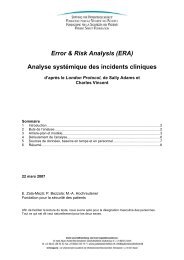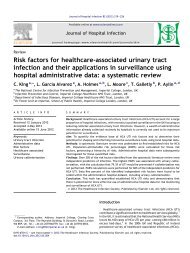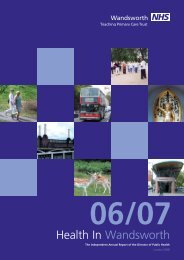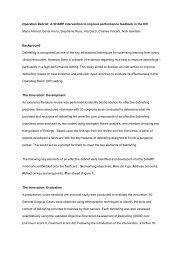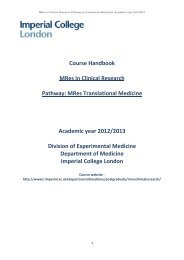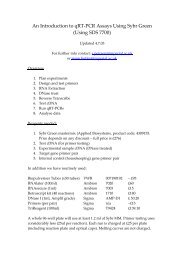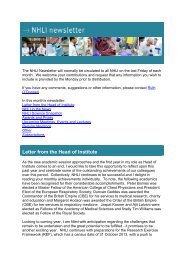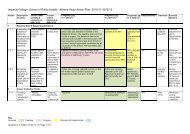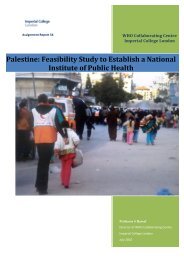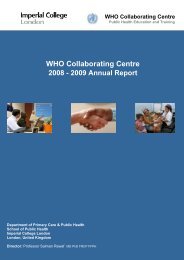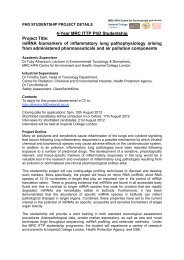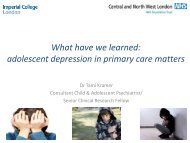QOF Plus Year 1 - Imperial College London
QOF Plus Year 1 - Imperial College London
QOF Plus Year 1 - Imperial College London
Create successful ePaper yourself
Turn your PDF publications into a flip-book with our unique Google optimized e-Paper software.
indicators compared to national rates is shown in Figure A2.7 (for explanation of how to interpretthe graph, see Section A3.2, p117). No practices in NHS Hammersmith and Fulham have EER’sexceeding 15% and only two exceed 10%.While Hammersmith and Fulham currently displays relatively low rates of exception reporting, itshould be noted that the absolute numbers involved are small and that these figures masksituations where – for individual indicators – local rates are higher than the national average (e.g.DM 20).Exception reporting and <strong>QOF</strong>+The exception reporting criteria used in <strong>QOF</strong>+ will remain the same as those in national <strong>QOF</strong>.An early proposal was that, for existing <strong>QOF</strong> indicators with revised upper thresholds, practiceswould need to keep below the 50 th centile of national rates of exception reporting in order toqualify for payment. Motivating this was a concern that, as targets were raised, the temptation toinappropriately exclude patients increases. It has been suggested, however, that the current[denominator - numerator] group contains disproportionate numbers of patients who mightultimately be legitimately excluded. Under this view, the fact that national levels of exceptionreporting have remained relatively static (Doran et al., 2006; Doran et al., 2008; The InformationCentre, 2008) reflects only the fact that current <strong>QOF</strong> targets are not yet high enough to force theissue.Negative feedback from practices consulted early in the <strong>QOF</strong>+ development process promptedfurther consultation on this issue from Professor Martin Roland and Dr Tim Doran who arerecognised experts in this field. They raised a specific concern about the validity of comparingexception reporting at even a local level because of the significant effect that inter-practicepopulation characteristics appear to have on rates of exception reporting. The nature of thesefactors is not well understood; early suggestions that exception reporting might be related tolevels of deprivation (Sigfrid et al., 2006) have recently been disputed by others (Doran et al.,2008). It is known that the uncertainty associated with a given rate of exception reportingincreases dramatically when disease register size drops below a certain level, which raises issuesfor validating exception reporting rates in small practices (The Information Centre, 2008). Withthese issues in mind, it was decided to abandon attempts to cap or control rates of exceptionreporting in <strong>QOF</strong>+ 08/09.Figure A2.8 is a scatter plot which relates mean exception reporting rate with attainment for the12 <strong>QOF</strong> clinical indicators for 28 practices in Hammersmith and Fulham. Diamonds outlined in redrepresent practices with below mean disease register sizes (normalised for practice list size) whilegreen filled diamonds represent those with above average register sizes. There is a clearassociation between increased attainment and higher rates of exception reporting (trend line isshown, calculated with circled outliers omitted the correlation coefficient is 0.72) and alsobetween higher rates of exception reporting and small register (not denominator) sizes. Althoughevidence collected to date suggests that gaming is a not a significant problem in the NHS as whole(Doran et al., 2008), the group is concerned about the possibility that high attainment locallymight be resulting from practices shaping their denominator profile in ways not consistent withthe spirit of <strong>QOF</strong>. There will be careful examination of how exception reporting rates change ofthe next twelve months.112



